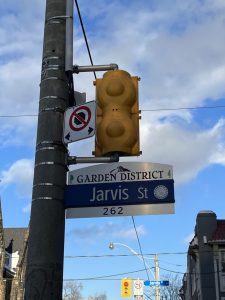Field Trip Sites
Jarvis Street
Kimberly Boissiere and Jeremie Caribou
Errett, J. (2016). Was Jarvis Street named after a city-builder, or a slave-owner? Prepare for a debate. CBC News: https://www.cbc.ca/news/canada/toronto/jarvis-street-slavery-1.3564667
- “Samuel Jarvis fought in the War of 1812, and was part of the city’s pioneering political class when Toronto was incorporated. His father, William Jarvis, was a militiaman and member of early local governments in York, the town that eventually became Toronto.””
- “Most historians aregue the Jarvises were unsavoury characters — ‘turkeys,’ ‘incompetent,’ ‘lazy,’ ‘selfish,’ and ‘dishonest’ are just some of the adjectives that can be found in Toronto literature to describe the father and son. Keeping to the facts, the Jarvis family were indeed slave-holders. The Jarvises owned at least six slaves, according to John Ross Robertson’s 1894 book Landmarks of Toronto, even as the mood and law in Upper Canada were decidedly anti-slavery.”
- “Samuel Jarvis, William’s son, is also not fondly remembered. The younger Jarvis was notoriously hostile to First Nations in Toronto. At one point, he even spent time in jail for murder.”

Daubs, K. (2020, July 1). Racism is literally written on the streets in Toronto. why are we still honouring these slaveowners, swindlers and residential school promoters? thestar.com://www.thestar.com/news/gta/2020/07/01/slaveowners-swindlers-residential-school-promoters-these-are-who-torontos-streets-are-named-after.html
- “After Jarvis died, his son Samuel Peters Jarvis eventually built a house called Hazel Burn on that park lot. From 1837 to 1845, Samuel was chief superintendent of Indian Affairs. In 1841, he pitched the Six Nations community on selling their land to the Crown. A handful of people agreed, but the community quickly petitioned the government that these men had acted independently, and the whole matter had been rushed and confused. It is contested to this day.”
- “As historian Susan Hill relays in “The Clay We Are Made Of: Haudenosaunee Land Tenure on the Grand River,” Samuel Jarvis invested money from the community trust without their consent into the Grand River Navigation Co., a doomed canal venture he was involved in. Jarvis combined his money with “Indian funds,” she writes, and “despite the fact that Jarvis could not account for funds taken … he was never prosecuted.””
- “According to the Dictionary of Canadian Biography, an 1844 Royal Commission found a chaotic mess in the Department of Indian Affairs with at least £4,000 missing under an “incompetent and possibly dishonest” Jarvis. (It’s not clear if this relates to the canal boondoggle or a separate matter) He retired “in disgrace,” and with ongoing debts, hired surveyor John Howard to subdivide a portion of his family’s lot around 1850, creating a series of new streets — including Jarvis Street. According to city records, the street was named for Samuel Peters Jarvis, not his father.”
